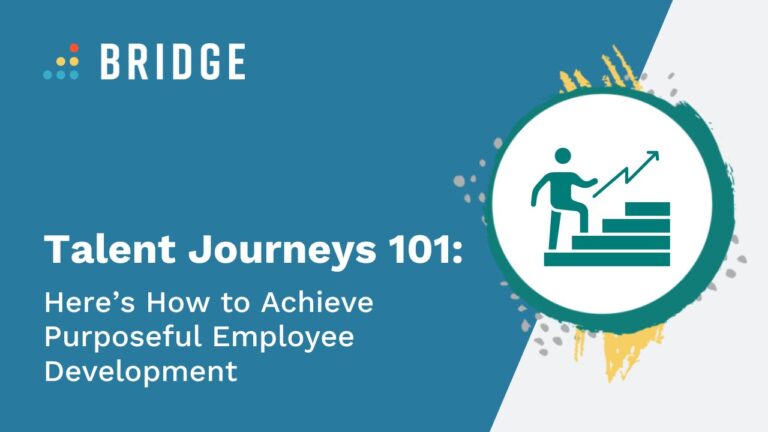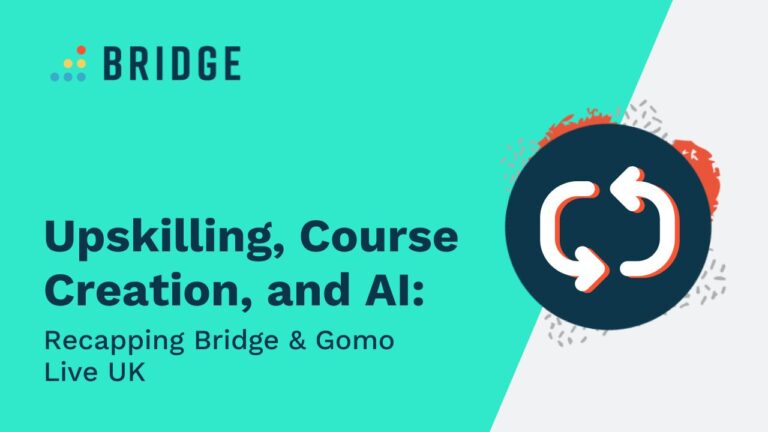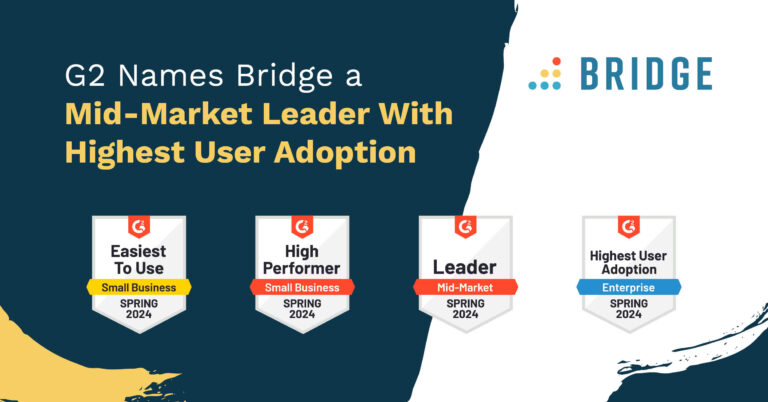Find out how talent journeys can lend shape and direction to your learning and development efforts while offering new levels of purpose to your employee upskilling initiatives.
No leader is content to put on the brakes. Growth, change, and forward momentum are the signs of a thriving business or a flourishing organization—but when the time comes to cement that growth, you might find a couple of barriers standing in the way.
Research from the World Economic Forum has found that, for several of the organizations it surveyed, business transformation is hindered by two key factors:
- The difficulties involved in closing skills gaps (60%)
- An inability to attract talent (53%)
Whether you’re looking to transform your organization or just ensure that it’s operating at its best, there’s no question that these widespread skills gaps and talent attraction problems need to be addressed. And wouldn’t it be handy if you could tackle both of these problems at once?
If you feel like we’re building up to something here, you’re absolutely right! Attracting talent and closing skills gaps are tasks made significantly easier with a robust and well-designed talent journey. Talent journeys refer to the sum total of your employees’ experiences, all the way from hiring to exiting your organization.
A good talent journey will close the gap between current and future workforce capabilities, and it’ll do so by meeting employee expectations around training, support, and mobility. That means you’ll be able to address skills gaps internally by guiding your people toward the skills and roles that need filling. Simultaneously, you’ll become a far more appealing employer to prospective hires—one that allows employees to fulfill their aspirations and add a dash of purpose to their professional lives.
So, what does a talent journey look like? What do they mean for employees and employers? Let’s find out.
What Is a Talent Journey?
A talent journey encompasses an employee’s path over the course of their time with an organization. This includes everything from hiring and onboarding to continuous learning and development, as well as career progression and departure.
From an employer perspective, the talent journey also includes compensation and organizational planning decisions, alongside the processes and technologies required to facilitate every employee’s journey.
It’s important not to be too rigid with your talent journeys. Every employee will walk their own path, especially when you allow for multi-directional movement across departments and disciplines. That said, there are a handful of basic components to a talent journey, including:
- Onboarding
- Development
- Advancement
- Assessment
MORE L&D ESSENTIALS | ‘How to Create an Employee Training Program In Ten Steps’
Why Talent Journeys Matter (For Employees and Organizations)
We’ve already touched on some of the key benefits of a good talent journey. Enhancing your workforce’s capabilities is already worth the price of admission, and when you can do so in such a way as to meet expectations around growth and employee development, all the better!
That said, it’s worth gaining a precise understanding of what employees want—and how talent journeys can fulfill those wants. Plus, it’s never a bad idea to reflect on the scale of the skills gap problems that a good talent journey can rectify. That’s why we’ve framed the benefits of talent journeys around two groups: employees and their employers.
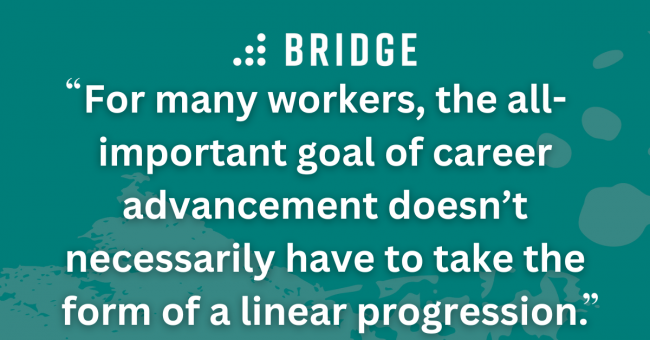
How Talent Journeys Help You Meet Employee Experience Expectations
Workers want career development, advancement, and purpose-filled professional lives. This might not sound like the biggest revelation in the world, but further breaking down employee sentiment toward advancement and development into demographic categories suggests that these ideas don’t mean the same thing to everyone. That means you’ll want to offer talent journeys that can cater to a variety of different perspectives on the employee experience.
Varied Forms of Career Advancement
Take the group that one McKinsey report describes as “traditionalists.” These are career-driven people who tend to remain with the same employer for extended periods, and they’re absolutely motivated by things like compensation and—sure enough—career advancement.
For this demographic, it’s fair to assume that career advancement is a linear process. That’s the traditional perspective, after all: one in which an employee sticks to the same field or discipline, slowly rising from (for example) the rank of junior accountant to CFO. But here’s the catch: the traditionalists aren’t the only group with their eyes on career advancement, and different demographics will approach the concept differently.
McKinsey identifies a different persona in the form of people who haven’t yet entered or returned to the workforce. Parents, carers, and passive job seekers aged 18-44 all fit into this crowd. To McKinsey, this group also wants to see “a pathway to advancement,” but only in concert with support and flexibility. It’s the same story for McKinsey’s “idealists”: younger, part-time workers who want career development and advancement alongside a flexible approach.
What does flexibility mean to these groups? It’s pretty wide-ranging, encompassing everything from working hours, workplace locations, and the autonomy to “decide what kind of work they would do.” This understanding of flexibility suggests that, for many workers, the all-important goal of career advancement doesn’t necessarily have to take the form of a linear progression. As such, you might find that you appeal to these groups more if your talent journeys facilitate internal mobility, which allows employees to make lateral moves toward different departments and disciplines.
By establishing a talent journey that provides this ultimate flexibility—the flexibility for employees to reskill and reinvent their professional lives and capabilities—your organization will find itself appealing to a wide array of demographics and personas. You’ll allow each employee to pursue a form of career advancement that works for them.
MORE ABOUT ADVANCEMENT | ‘Internal Mobility vs Talent Mobility: Here’s the Difference (And Why It Matters)’
Putting Purpose at the Heart of the Employee Experience
McKinsey’s idealists have another trait worth noting: they look for organizations that place a cultural emphasis on meaning and purpose. This isn’t an isolated phenomenon, but a growing trend. Gartner's research suggests that, alongside “growth opportunities,” employees are deeply interested in feeling a sense of purpose in their work, and they also want to bring their authentic selves to their professional lives.
Again, a good talent journey will meet these high expectations. It’ll allow your prospective hires and current employees the opportunity to grow in a direction that suits their interests and passions. It’ll also offer a structured process for advancement alongside a flexible approach to ongoing development. As a result, your people will be able to find and move toward the aspects of their careers that provide value and meaning.
This doesn’t mean every employee will feel the need to move in a radical new direction during the course of their talent journeys. But giving them the option to pursue greater autonomy as they grow and advance is the perfect way to adopt the human-centric, trusting, and empowering principles that today’s top talent expects.
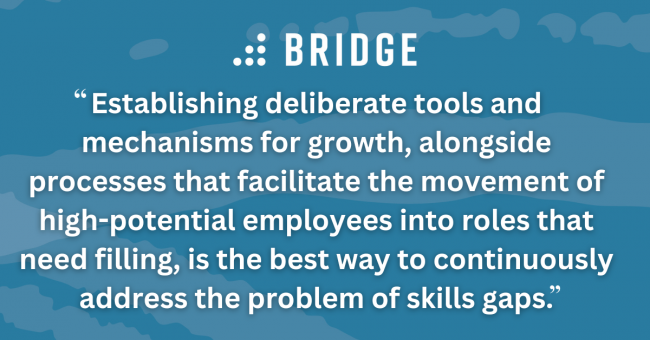
What Talent Journeys Mean for Employers
Meeting employee expectations around flexibility, autonomy, and purpose is already reason enough to bolster your talent journeys—but it doesn’t end there. Fostering a culture of development and advancement is the perfect way to fill your organization’s skills gaps by looking internally, even as you make your organization more attractive to outside hires.
There’s no question that organizations are trying to address their skills gaps by looking internally. In fact, 81% of recruitment professionals surveyed by LinkedIn said that upskilling and reskilling are factors likely to be important in shaping the future of recruiting between 2023 and 2028. This approach comes part and parcel with a development-first talent journey, which will give employees the skills-related resources they need to grow into current and future roles.
In fact, this is a view that one McKinsey report directly connects to talent journeys. The report notes that, to find the highest-potential employees in the tech industry, “HR leaders must look inside the company as well as outside.” This is an approach that can only be achieved with the help of a talent journey process that allows employees to reskill and move internally. The report itself says as much, stressing that attracting and retaining tech talent is all about centering the needs of that talent “all along the talent journey.”
All this is to say that solid, well-conceived talent journeys are an excellent way to meet workforce capability needs. While this isn’t a complex idea, it’s still one that needs to be emphasized. It’s easy to fall into the trap of limiting your employees’ journeys to a purely linear advancement path—or, worse still, to neglect meaningful or targeted development at all. Establishing deliberate tools and mechanisms for growth, alongside processes that facilitate the movement of high-potential employees into roles that need filling, is the best way to continuously address the problem of skills gaps.
FILL YOUR CAPABILITY CHASMS | ‘Want to Address Your Skills Gaps? Here’s How AI-Assisted Skills Assessments Can Help’
The Forces That Shape Talent Journeys
The case for fostering a skills-gap-solving, purpose-filled talent journey is pretty clear. But despite worker enthusiasm for pursuing development and advancement opportunities, you’ll still want to make sure that you can place your talent journey process in a broader economic context. Without considering crucial financial and wellbeing factors, you might fall foul of the limitations that can prevent your workers from exploring their paths to the fullest.
Tackling Promotion Pessimism Amid Economic Uncertainty
Economic instability is one of the harder-to-ignore issues your workforce faces.
According to a global survey from Deloitte published in mid-2023, around 6 in 10 Gen Zs and a similar proportion of Millennials believe the economy will either stay the same or worsen in the next year. More importantly (for our purposes), many of the people who hold that view think that this economic outlook will make it “harder or impossible” to get:
- A raise
- A promotion
- A new job
- Greater job flexibility
This attitude impacts talent journeys in two potentially contradictory ways.
On the one hand, talent journeys are a fantastic corrective for pessimism around promotions, new jobs, and certain kinds of flexibility. Talent journeys offer a structured process for growth and mobility within an organization while also reframing what advancement looks like, allowing employees the flexibility to explore other fields of interest through lateral moves as well as upward ones. All of these qualities allow workers to counteract the stagnancy that Deloitte’s respondents associate with less-than-ideal economic circumstances.
That said, some research has found that financial stress can (depending on how you interpret the data) lead to lower participation in the upskilling activities that form the core of a successful talent journey.
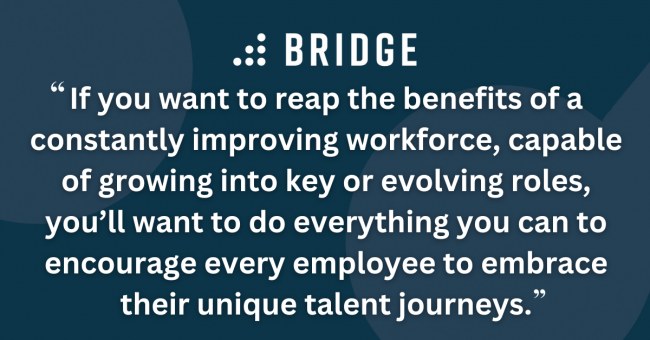
Mitigating Financial Stressors and Making Talent Journeys Simple to Engage With
So, what’s the evidence that financial uncertainty can lead to a reduced engagement with the talent journey?
Well, 2023 research from PwC found that there’s a relationship at play between financial stress and upskilling. PwC’s survey revealed that 62% of people who can comfortably pay bills report actively seeking out opportunities to learn new skills. By contrast, that attitude was only held by 50% of people who struggle with their bills.
The researchers do point out that it’s unclear which way the relationship runs here. It could be that habitual upskillers tend to earn more, or it could equally be that those who earn less lack the resources to engage in upskilling. But whatever the reason might be, the result amounts to the same thing: not all employees will be in a position to engage in the development activities at the heart of the talent journey, effectively stalling that journey.
So, what’s the answer here? If you want to reap the benefits of a constantly improving workforce, capable of growing into key or evolving roles, you’ll want to do everything you can to encourage every employee to embrace their unique talent journeys. When it comes to struggling workers, that might mean helping them to address their financial difficulties—but it also means ensuring that your organization is equipped with the processes and technologies that make the talent journey a smooth, enjoyable, and easy-to-embrace experience for your entire workforce.
You’re Just a Step Away From a Wealth of Talent Journey Insights
For an in-depth guide to perfecting your organization’s talent journeys, we’ve got a whole ebook ready and waiting. And if you want to know how Bridge’s suite of learning technologies can help you to automate employee onboarding, track performance, and upskill with purpose, request a demo today.
